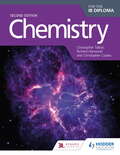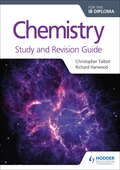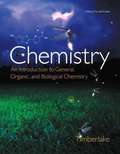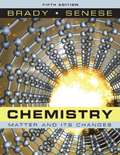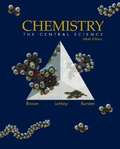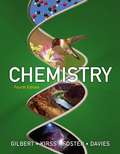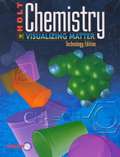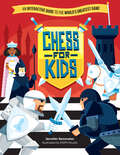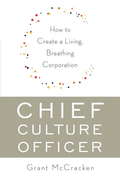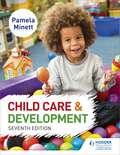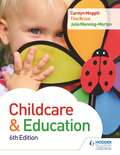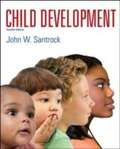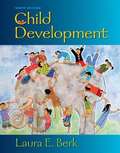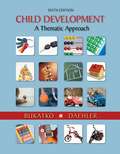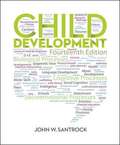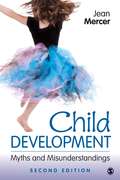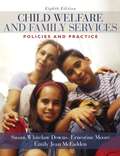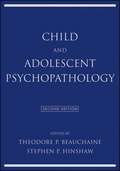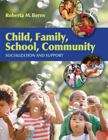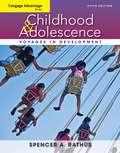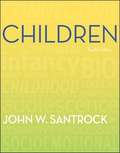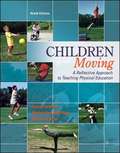- Table View
- List View
Chemistry for the IB Diploma Second Edition
by Christopher Coates Christopher Talbot Richard HarwoodProvide clear guidance to the 2014 changes and ensure in-depth study with accessible content, directly mapped to the new syllabus and approach to learningThis second edition of the highly-regarded first edition contains all SL and HL content, which is clearly identified throughout. Options are available free online, along with appendices and data and statistics.- Improve exam performance, with exam-style questions, including from past papers- Integrate Theory of Knowledge into your lessons and provide opportunities for cross-curriculum study- Stretch more able students with extension activities- The shift to concept-based approach to learning , Nature of Science, is covered by providing a framework for the course with points for discussion - Key skills and experiments included - Full digital package - offered in a variety of formats so that you can deliver the course just how you like!
Chemistry for the IB Diploma Study and Revision Guide
by Christopher Talbot Richard HarwoodStretch your students to achieve their best grade with these year round course companions; providing clear and concise explanations of all syllabus requirements and topics, and practice questions to support and strengthen learning. - Consolidate revision and support learning with a range of exam practice questions and concise and accessible revision notes- Practise exam technique with tips and trusted guidance from examiners on how to tackle questions- Focus revision with key terms and definitions listed for each topic/sub topic
Chemistry for the IB MYP 4 & 5: By Concept (MYP By Concept)
by Christopher Talbot Annie TermaatThe only series for MYP 4 and 5 developed in cooperation with the International Baccalaureate (IB)Develop your skills to become an inquiring learner; ensure you navigate the MYP framework with confidence using a concept-driven and assessment-focused approach presented in global contexts.- Develop conceptual understanding with key MYP concepts and related concepts at the heart of each chapter.- Learn by asking questions with a statement of inquiry in each chapter. - Prepare for every aspect of assessment using support and tasks designed by experienced educators.- Understand how to extend your learning through research projects and interdisciplinary opportunities.This title is also available in two digital formats via Dynamic Learning. Find out more by clicking on the links at the top of the page.
Chemistry: An Introduction to General, Organic, and Biological Chemistry (12th Edition)
by Karen C. TimberlakeFor one-semester courses in General, Organic, and Biological Chemistry Show the importance of chemistry in the real world Chemistry: An Introduction to General, Organic, and Biological Chemistry, Twelfth Edition is the ideal resource for today's allied health students. Assuming no prior knowledge of chemistry, author Karen Timberlake engages students through her friendly presentation style and reveals connections between the structure and behavior of matter and its role in health and the environment.
Chemistry: Matters and Its Changes
by James E. Brady Fred Senese Neil D. JespersenWritten by Jim Brady, an author well known for his ability to communicate chemistry, and Fred Senese, the architect of the most visited general chemistry Web site, this book and its media are designed to support a variety of backgrounds.
Chemistry: The Central Science
by H. Eugene Lemay Theodore E. Brown Julia R. Burdge Bruce Edward BurstenThe acknowledged leader and standard in general chemistry, this book maintains its effective and proven features--clarity of writing, scientific integrity, currency, strong exercises, visual emphasis and consistency in presentation. It offers readers an integrated educational solution to the challenges of the learning with an expanded media program that works in concert with the book, helping them to approach problem solving, visualization, and applications with greater success.
Chemistry: The Science in Context (Fourth Edition )
by Thomas R. Gilbert Rein V. Kirss Natalie Foster Geoffrey DaviesThis book introduces the chemical principles using contexts drawn from daily life as well as from other disciplines including biology, environmental science, materials science, astronomy, geology, and medicine.
Chemistry: Visualizing Matter
by Salvatore Tocci R. Thomas Myers Keith B. OldhamChemistry textbook for college students.
Cherry Blossoms After Winter: Volume 1 (Cherry Blossoms After Winter #1)
by BamwooDespite growing up together, these childhood friends have grown apart. The fan-favorite boys&’ love manhwa turned K-drama comes to print for the first time.Seo Haebom was seven years old when his parents died in an accident. With nowhere else to go, he moves in with the family of his childhood friend Jo Taesung, who suddenly grows cold and distant, destroying their friendship.Now it&’s their senior year of high school and, after years of barely speaking to each other, Haebom and Taesung are in the same class for the first time. Haebom struggles to make friends and is plagued by bullying, but after the handsome and popular Taesung fends off his most persistent bully, everything changes—they sit together at lunch and begin to act like friends again. Haebom is unsure what to make of the shift, but this could be his last chance to mend their relationship.Volume 1 includes episodes 1–15 of the webcomic Cherry Blossoms After Winter.
Cherry Heaven
by L J AdlingtonIt is 10 years after the events in The Diary of Pelly D. A new life in The New Frontier overseas beckons Kat and Tanka, far from the terrible war in the cities, that took their parents. In a beautiful new home, Cherry Heaven, where people are building a young, liberal society, without focus on the genetic categorization and discrimination that led to the war. But all too soon Kat and Tanka find that Cherry Heaven carries haunting marks of the past. They cannot run from them, and must finally and turn and face them. Again, L. J Adlington weaves her narrative expertly from two voices, Kat, teenage, light, modern and knowing, the other a disturbed, fragmented narrative from another girl which peals away the surface of the New Frontier to expose a different and more disturbing truth. Exploring issues of postwar guilt and redemption, tension and reconciliation, framed in a fast-moving mystery, this has the same engrossing readability and accessibility as Pelly D.
Chess for Kids: An Interactive Guide to the World's Greatest Game
by Jennifer KemmeterThis engaging workbook introduces kids to the wonderful world of chess—from an explanation of every piece on the board to the fundamentals of the game and strategies to capture pieces and win—all told through fun visuals, mock games, and exciting exercises. Chess for Kids includes:A comprehensive introduction to the king, queen, knights, bishops, rooks, and pawns and how each piece moves, attacks, and defends.Detailed explanations of the basic rules of chess, tactics, strategies, mating patterns, and piece strategies.Write-in, workbook activities to help kids &‘learn by doing,&’ unlike other chess books which are text heavy and not interactive. The best offensive and defensive strategies including how to find weak spots in your opponent's defense and how to close games when most of the board&’s pieces are gone.Learn the pieces, study the strategies, and checkmate all your opponents in this complete guide to mastering the game of chess!
Chief Culture Officer: How to Create a Living, Breathing Corporation
by Grant MccrackenLevi-Strauss, the jeans and apparel maker, missed out on the hip-hop trend. They didn't realize that those kids in baggy jeans represented a whole new--and lucrative--market opportunity, one they could have seen coming if they had but been paying attention to the shape of American culture. Levi Strauss isn't alone. Too many corporations outsource their understanding of culture to trend hunters, cool watchers, marketing experts, consulting firms, and, sometimes, teenage interns. The cost to Levi-Strauss was a billion dollars. The cost to the rest of corporate America is immeasurable. The lesson? The American corporation needs a new professional. It needs a Chief Culture Officer. Grant McCracken, an anthropologist who now trains some of the world's biggest companies and consulting firms, argues that the CCO would keep a finger on the pulse of contemporary cultural trends--from sneakers to slow food to preppies--while developing a systematic understanding of the deep waves of culture in America and the world. The CCO's professionalism would allow the corporation to see coming changes, even when they only exist as the weakest of signals. Delightfully authoritative, trenchantly on point, bursting with insight and character, Chief Culture Officer is sure to expand your horizons--and your business.
Child Care and Development 7th Edition
by Pamela MinettDeliver a detailed and focused Child Development course with the 7th edition of this textbook from Pamela Minett, designed to cover all the relevant topics in concise and highly illustrated chapters. - Quickly access individual topic areas with concise, focused and clearly laid out chapters.- Build knowledge and understanding with ongoing summative questions at the end of each chapter.- Engage learners with 100s of illustrations and photographs to support understanding of key concepts.- Suitable for all Level 1 and Level 2 specifications.
Child Care and Education 6th Edition
by Tina Bruce Carolyn Meggitt Julia Manning-MortonDeliver an in depth programme of teaching for level 3 and level 4 with this classic textbook that inspires your students to go further.Written by an expert team of childcare authors, the sixth edition of this classic textbook offers an in-depth approach to Childcare and Early Years study unmatched by any course specific texts. Child Care and Education 6th Edition provides full details of all the topics and frameworks relevant to level 3 and level 4 qualifications. It offers the opportunity to analyse and explore theories and practice at a high level of detail.- Provides post level 3 material in clearly marked 'Moving On' sections at the end of each chapter.- Focuses on the practicalities of working within a real-life setting using case studies and observation tasks.- Suitable for level 3 qualifications and courses that bridge the gap between levels 3 and 4.
Child Development (12th edition)
by John W. SantrockA standard textbook that emphasizes an extremely up-to-date (more than 250 references from 1993, 1994, and in-press sources) presentation of research in the three primary domains of child development: biological processes, cognitive processes, and socioemotional processes. The changes in this edition include increased and updated coverage of culture, ethnicity, and gender; families and parenting; and health and well-being. Annotation c. by Book News, Inc., Portland, Or.
Child Development (Ninth Edition)
by Laura E. BerkA best-selling, topically organized child development text, Berk’s Child Development is relied on in classrooms worldwide for its clear, engaging writing style, exceptional cross-cultural and multi-cultural focus, rich examples, and long-standing commitment to presenting the most up-to-date scholarship while also offering students research-based, practical applications that they can relate to their personal and professional lives. Berk takes an integrated approach to presenting development in the physical, cognitive, emotional, and social domains; emphasizes the complex interchanges between heredity and environment; and provides exceptional attention to culture. Laura Berk, renowned professor and researcher, presents the latest theories and findings in the field to students in a manageable and relevant way. Berk’s signature storytelling style invites students to actively learn beside the text’s “characters,” who experience real issues in development, including physical, cognitive, and peer challenges, as well as parenting and educational concerns. Berk also helps students connect their learning to their personal and professional areas of interest. Her voice comes through when speaking directly about issues students will face in their future pursuits as parents, educators, heath care providers, social workers, and researchers. As members of a global and diverse human community, students are called on to intelligently approach the responsibility of understanding and responding to the needs and concerns of children. While carefully considering the complexities of child development, Berk presents classic and emerging theories in an especially clear, engaging writing style, with a multitude of research-based, real-world, and cross-cultural examples. Strengthening the connections among developmental domains and among theory, research, and applications, this edition's extensive revision brings forth the most recent scholarship, representing the changing field of child development.
Child Development: A Thematic Approach
by Danuta Bukatko Marvin W. DaehlerBukatko/Daehler's CHILD DEVELOPMENT: A THEMATIC APPROACH provides a comprehensive, topically organized, up-to-date picture of development from conception to adolescence. Most important, it draws students' attention to the themes that replay themselves throughout the course of development, fundamental issues that resurface continually and that provide coherence to sometimes seemingly disparate research. The themes can serve as frameworks to help students further understand and remember the multitude of facts about child development. Bukatko/Daehler's sixth edition text draws on five themes, Nature and Nurture, Sociocultural Influence, Continuity/Discontinuity, Interaction among Domains, and Risk/Resilience. By drawing on these themes, the authors hope to stimulate readers to think about the process of development, or why it proceeds as it does. Through new For Your Review and Reflection sections, the authors also hope students will engage with the text and become more adept critical thinkers, who are more likely to appreciate the ramifications of theory and research for applied issues such as parenting practices, education, and social policy for children, which are ultimately concerns for us all.
Child Development: An Introduction (Fourteenth Edition)
by John W. SantrockThorough. Accurate. Reliable. Engaging. These are just a few of the words used by adopters and reviewers of John Santrock's Child Development. The new topically-organised fourteenth edition continues with Santrock's highly contemporary tone and focus, featuring over 1,000 new citations. The popular Connections theme shows students the different aspects of children's development to help them better understand the concepts. Used by hundreds of thousands of students over thirteen editions, Santrock's proven learning goals system provides a clear roadmap to course mastery.
Child Development: Myths and Misunderstandings (2nd Edition)
by Jean MercerIn Child Development: Myths and Misunderstanding Second Editions, Jean Mercer uses intriguing vignettes and questions about children and families to guide readers in thinking critically about 59 common beliefs. Each essay confronts commonly held misconceptions about development, encouraging students to think like social scientists and to become better consumers of media messages and anecdotal stories.
Child Welfare and Family Services: Policies and Practice (Eighth Edition)
by Susan Downs Ernestine Moore Emily Jean McfaddenIntended for use in collaborative programs bringing together public child welfare agencies and schools of social work, this textbook takes a deliberately broad approach to child services. Chapters concentrate on topics like rights and responsibilities, the prevention of maltreatment, day care and child development programs, family income security, court intervention, protection from neglect and abuse, family preservation, foster care, adoption, delinquency, and professional responsibilities. Annotation ©2004 Book News, Inc., Portland, OR (booknews.com)
Child and Adolescent Psychopathology (2nd Edition)
by Theodore P. Beauchaine Stephen P. HinshawChild and Adolescent Psychopathology, Second Edition is the only comprehensive text on childhood and adolescent disorders that addresses genetic, neurobiological, and environmental factors within a developmental perspective. The new edition includes more on epigenetics, classification, culture and context and emphasizes how, when, and why disorders emerge among young people and in what ways symptom profiles change at different stages of development.
Child, Family, School, Community: Socialization and Support (Eighth Edition)
by Roberta M. BernsBerns' CHILD, FAMILY, SCHOOL, COMMUNITY (CFSC) is intended for child, family, school, and community relations courses offered in both community and 4-year colleges. CFSC examines how the school, family, and community influence children's socialization. Roberta Berns uses Bronfenbrenner's Bioecological Model of Human Development as a framework. Courses for which CFSC is appropriate are often titled: Socialization of the Child; Child and Society, or Child in Society; Child, Family, and Community; or Child Development in the Family and Community. The course is frequently taken by future teachers, education paraprofessionals (e. g. , child care workers), and psychology, sociology or human ecology majors. The course can be found in various departments, including Human/Child Development, Early Childhood Education; Child/Family Relations; Sociology; Psychology or Psychology/Social Behavior; Home Economics; Human or Social Ecology, and Teacher Education. The course is a requirement for California Early Childhood Education certification and is offered at most California community colleges.
Childhood and Adolescence: Voyages in Development (Fifth Edition)
by Spencer A. RathusSpencer A. Rathus provides a hands-on approach in the chronologically organized CHILDHOOD AND ADOLESCENCE: VOYAGES IN DEVELOPMENT, Fifth Edition, augments your goal of helping students understand the link between developmental theories and research and their application to everyday life. Using his proven pedagogical approach, interspersed with personal and humorous stories, Rathus makes reading and studying an enjoyable process of discovery.
Children (Twelfth Edition)
by John SantrockJohn Santrock's Children combines proven pedagogy and the most current research to provide a market leading presentation of child development. This time tested text provides compelling contemporary research, including updates from eight leading experts in the field. The text's accessible presentation, plentiful applications and engaging writing foster increased mastery of the content. The new edition includes substantially expanded material on subjects including children's health and well-being, parenting and education, diversity, culture, and gender.
Children Moving: A Reflective Approach to Teaching Physical Education
by George Graham Shirley Ann Holt/Hale Melissa ParkerThe authors of Children Moving, however, recognize that each child is unique. One size does not fit all! Thus, Children Moving guides you in the process of learning to teach a curriculum that is differentiated for a range of skill abilities and fitness levels. If all children were the same, we would be able to package a curriculum with the same games and the same gymnastic stunts and dances you would do with all of the children as if they were identical. Children Moving, on the other hand, introduces you to the reflective approach--a process of teaching that provides the background for you to adapt, adjust, and modify lessons so they are interesting and worthwhile for all of the children you teach--from the lowest to the highest skill and fitness levels. The ultimate goal, of course, is to guide youngsters in the process of becoming physically active for a lifetime.
